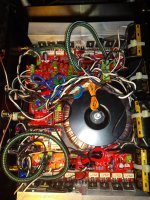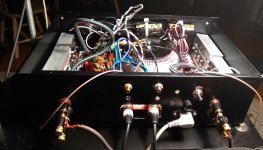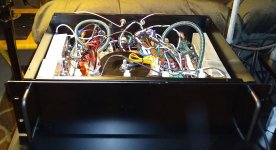Hello,
I have successfully constructed a 300 watt power amplifier based on Michael Chua's C300 design. It is not designed to be the best possible design given currently available components. Rather, it is designed to use the most widely available and the minimum number of types of components so that it will be more likely to be able to be continue to be built into the future. It is for educational and archival purposes as well as audio enjoyment. I have made numerous modifications and improvements. There are four PCBs available which combined can be used to construct a fairly complete amplifier unit:
1. Amplifier PCB
2. Soft Start PCB
3. Power conditioning PCB
4. Balanced to unbalanced receiver PCB
The project is at
GitHub - profdc9/PowerAmpAudio: Power Amplifier based on Michael Chua's C300 amplifier
You can download the entire project to your computer by clicking the green "Code" button and then "Download ZIP."
There are instructions on the github about the PCBs and how to build them. All the PCBs include gerbers, BOMs, and schematics. The projects are all created with Kicad so they may be modified using open source software. The project is available under the Creative Commons Attribution/Share-Alike 4.0 license which permits commercial or non-commercial use.
Special thanks to Hans Polak for his suggestion to add TPC compensation.
Pictures of the prototype have been included. Sorry for the spaghetti cable mess, it will be cleaned up.
Please let me know if you have any questions or comments.
Best,
Dan
I have successfully constructed a 300 watt power amplifier based on Michael Chua's C300 design. It is not designed to be the best possible design given currently available components. Rather, it is designed to use the most widely available and the minimum number of types of components so that it will be more likely to be able to be continue to be built into the future. It is for educational and archival purposes as well as audio enjoyment. I have made numerous modifications and improvements. There are four PCBs available which combined can be used to construct a fairly complete amplifier unit:
1. Amplifier PCB
2. Soft Start PCB
3. Power conditioning PCB
4. Balanced to unbalanced receiver PCB
The project is at
GitHub - profdc9/PowerAmpAudio: Power Amplifier based on Michael Chua's C300 amplifier
You can download the entire project to your computer by clicking the green "Code" button and then "Download ZIP."
There are instructions on the github about the PCBs and how to build them. All the PCBs include gerbers, BOMs, and schematics. The projects are all created with Kicad so they may be modified using open source software. The project is available under the Creative Commons Attribution/Share-Alike 4.0 license which permits commercial or non-commercial use.
Special thanks to Hans Polak for his suggestion to add TPC compensation.
Pictures of the prototype have been included. Sorry for the spaghetti cable mess, it will be cleaned up.
Please let me know if you have any questions or comments.
Best,
Dan
Attachments
Its well packed in.
Plenty of output transistors, easily get 300WRMS with those.
I have used PC cases in some of my projects as they are cheap and have loads of room.
They also come with mains sockets, mains switch and fan housing.
Plenty of output transistors, easily get 300WRMS with those.
I have used PC cases in some of my projects as they are cheap and have loads of room.
They also come with mains sockets, mains switch and fan housing.
Only thing I’d be worried about is heat sinking efficiency. When oriented in that direction, they normally use forced air. There is little convection unless hot air can rise thru the fins. Is it possible to turn the fins vertical?
Definitely needs a fan and vents as heat sinks are inside the case.
I had a fan fail on me on my mobile disco amp.
Luckily I had used a massive heatsink and while it got very hot it didnt fail.
However, my pint of beer on top of the case was pretty warm to drink after a while !
I had a fan fail on me on my mobile disco amp.
Luckily I had used a massive heatsink and while it got very hot it didnt fail.
However, my pint of beer on top of the case was pretty warm to drink after a while !
Only thing I’d be worried about is heat sinking efficiency. When oriented in that direction, they normally use forced air. There is little convection unless hot air can rise thru the fins. Is it possible to turn the fins vertical?
I am probably going to have to cut slots in the side of the case.
It is ok at low power but can get toasty.


